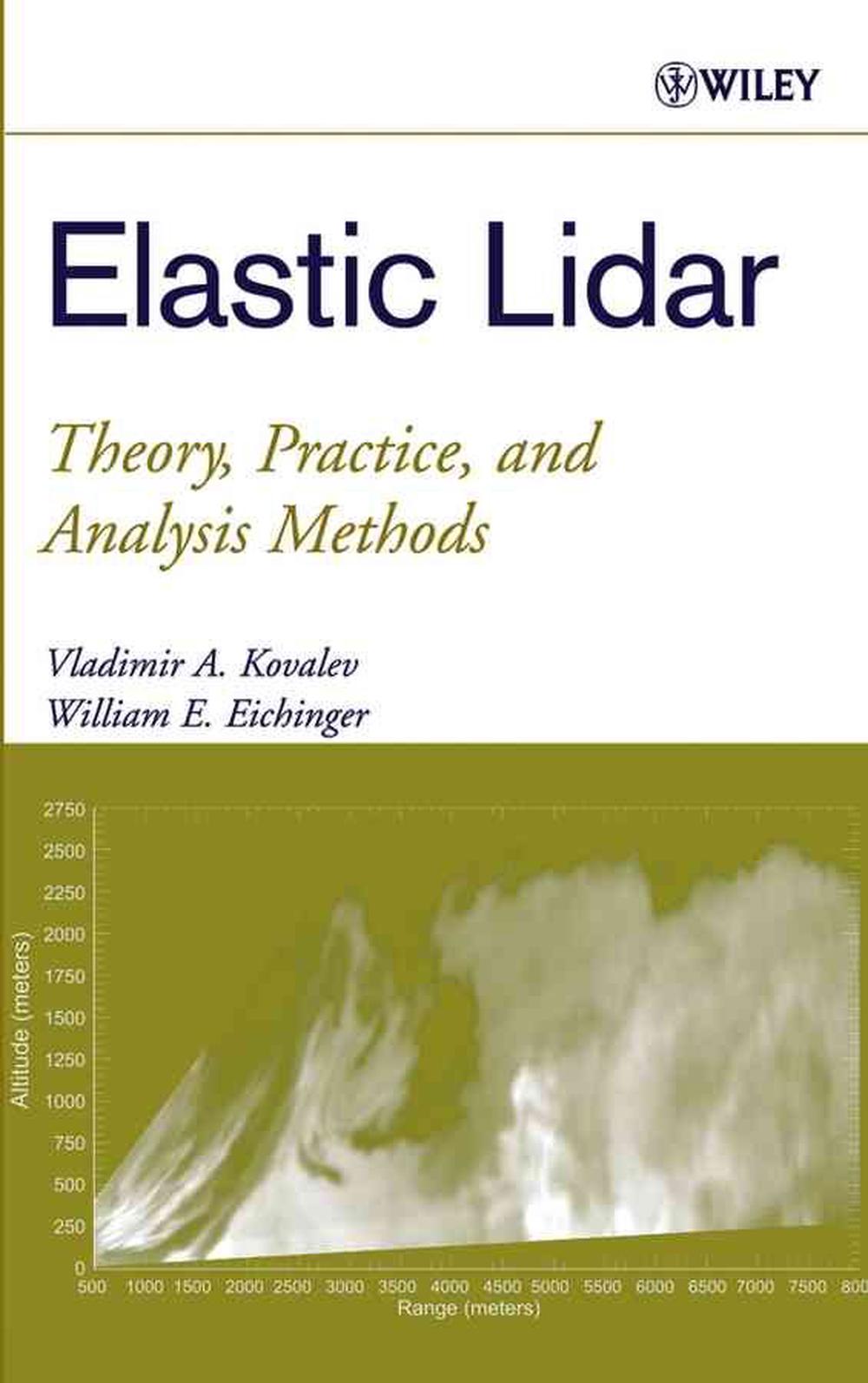
When you click on links to various merchants on this site and make a purchase, this can result in this site earning a commission. Affiliate programs and affiliations include, but are not limited to, the eBay Partner Network.
Elastic Lidar: Theory, Practice, and Analysis Methods by Vladimir A. Kovalev (En

- Item No : 365477568470
- Condition : Brand New
- Brand : No brand Info
- Seller : the_nile_uk_store
- Current Bid : US $296.51
-
* Item Description
-
The Nile on eBay

Elastic Lidar
by Vladimir A. Kovalev, William E. Eichinger
* Focuses only on elastic lidars and directly related topics.
* Evaluates all of the major inversion and analysis methods.
* Covers an emerging field that is generating a lot of interest.FORMAT
HardcoverLANGUAGE
EnglishCONDITION
Brand New
Publisher Description
* Focuses only on elastic lidars and directly related topics.
* Evaluates all of the major inversion and analysis methods.
* Covers an emerging field that is generating a lot of interest.Back Cover
A comprehensive overview of lidar technology Over the forty years since the invention of the laser, optical and electronic technology has made great strides, enabling the practical use of lidar in many fields. As lidar technology moves from being an object of research to providing data for other types of researchers to use, it becomes increasingly important to have a resource that explains the topic simply, yet thoroughly. Intended as a handbook for researchers, graduate students, and lidar users, Elastic Lidar: Theory, Practice, and Analysis Methods bridges a twenty-year gap in the lidar literature and brings its subject into the twenty-first century. Focusing on elastic lidars, the most common type of lidars in use today, the authors, both researchers in the field, provide a comprehensive discussion of practical elastic lidar methodology and inversion techniques, data analysis methods, and the construction of elastic lidars. The book provides lidar professionals and students alike with clear and simple explanations of: How lidars work Data inversion techniques Construction of elastic lidars How to extract information from the data lidars provide Based on their own professional experience, the authors provide readers with a straightforward explanation of what lidar technology can and cannot do with the methods currently available, while providing alternate viewpoints so that readers can draw their own conclusions.
Flap
A comprehensive overview of lidar technology Over the forty years since the invention of the laser, optical and electronic technology has made great strides, enabling the practical use of lidar in many fields. As lidar technology moves from being an object of research to providing data for other types of researchers to use, it becomes increasingly important to have a resource that explains the topic simply, yet thoroughly. Intended as a handbook for researchers, graduate students, and lidar users, Elastic Lidar: Theory, Practice, and Analysis Methods bridges a twenty-year gap in the lidar literature and brings its subject into the twenty-first century. Focusing on elastic lidars, the most common type of lidars in use today, the authors, both researchers in the field, provide a comprehensive discussion of practical elastic lidar methodology and inversion techniques, data analysis methods, and the construction of elastic lidars. The book provides lidar professionals and students alike with clear and simple explanations of: How lidars work Data inversion techniques Construction of elastic lidars How to extract information from the data lidars provide Based on their own professional experience, the authors provide readers with a straightforward explanation of what lidar technology can and cannot do with the methods currently available, while providing alternate viewpoints so that readers can draw their own conclusions.
Author Biography
VLADIMIR A. KOVALEV, PHD, is an atmospheric physicist in the Fire Sciences Laboratory, Rocky Mountain Research Station, USDA Forest Service, Missoula, Montana. WILLIAM E. EICHINGER, PHD, is a professor in the Department of Civil and Environmental Engineering at the University of Iowa.
Table of Contents
Preface. Definitions. 1. Atmospheric Properties. 1.1 Atmospheric Structure. 1.2 Atmospheric Properties. 2. Light Propagation in the Atmosphere. 2.1 Light Extinction and Transmittance. 2.2 Total and Directional Elastic Scattering of the Light Bean. 2.3 Light Scattering by Molecules and Particulates: Inelastic Scattering. 2.4 Light Absorption by Molecules and Particulates. 3. Fundamentals of the Lidar Technique. 3.1 Introduction to the Lidar Technique. 3.2 Lidar Equation and Its Constituents. 3.3 Elastic Lidar Hardware. 3.4 Practical Lidar Issues. 3.5 Eye Safety Issues and Hardware. 4. Detectors, Digitizers, Electronics. 4.1 Detectors. 4.2 Electric Circuits for Optical Detectors. 4.3 A-D Converters/Digitizers. 4.4 General. 5. Analytical Solutions of the Lidar Equation. 5.1 Simple Lidar-Equation Solution for a Homogene ous. 5.2 Basic Transformation of the Elastic Lidar Equation. 5.3 Lidar Equation Solution for a Single-Component Heterogeneous Atmosphere. 5.4 Lidar Equation Solution for a Two-Component Atmosphere. 5.5 Which Solution is Best? 6. Uncertainty Estimation for Lidar Measurements. 6.1 Uncertainty for the Slope Method. 6.2 Lidar Measurement Uncertainty in a Two-Component Atmosphere. 6.3 Background Constituent in the Original Lidar Signal and Lidar Signal Averaging. 7. Backscatter-to-Extinction Ratio. 7.1 Exploration of the Backscatter-to-Extinction Ratio on the Inversion Result. 7.2 Influence of Uncertainty in the Backscatter-to-Extinction Ratio. 8. Lidar Examination of Clear and Moderately Turbid Atmospheres. 8.1 One-Directional Lidar Measurements: Methods and Problems. 8.2 Inversion Techniques for a "Spotted" Atmosphere. 9. Multiangle Methods for Extinction Coefficient Determination. 9.1 Angle-Dependent Lidar Equation and Its Basic Solution. 9.2 Solution for the Layer-Integrated Form of the Angle-Dependent Lidar Equation. 9.3 Solution for the Two-Angle layer-Integrated Form of the Lidar Equation. 9.4 Two-Angle Solution for the Angle-Independent Lidar Equation. 9.5 High-Altitude Tropospheric Measurements with Lidar. 9.6 Which Method Us the Best? 10. Differential Absorption Lidar Technique (DIAL). 10.1 DIAL Processing Technique: Fundamentals. 10.2 DIAL Processing Technique: Problems. 10.3 Other Techniques for DIAL Data Processing. 11. Hardware Solutions to the Inversion Problem. 11.1 Use of N2 Raman Scattering for Extinction Measurement. 11.2 Resolution of Particulate and Molecular Scattering by Filtration. 11.3 Multiple-Wavelength Lidars. 12. Atmospheric Parameters from Elastic Lidar Data. 12.1 Visual Range in Horizontal Directions. 12.2 Visual Range in Slant Directions. 12.3 Temperature measurements. 12.4 Boundary Layer Height Determination. 12.5 Cloud Boundary Determination. 13. Wind Measurement Methods from Elastic Lidar Data. 13.1 Correlation Methods to Determine Wind Speed and Direction. 13.2 Edge Technique. 13.3 Fringe Imaging Technique. 13.4 Kinetic Energy, Dissipation Rate, and Divergence. Bibliography. Index.
Review
"A comprehensive overview of lidar technology, this handbook is intended for researchers, graduate students and lidar users." (Sea Technology, November 2004) "This book should be of significant value to researchers applying remote sensing to atmospheric problems, and of course will be of great interest to lidar specialists." (E-STREAMS, November 2004)
Long Description
A comprehensive overview of lidar technology Over the forty years since the invention of the laser, optical and electronic technology has made great strides, enabling the practical use of lidar in many fields. As lidar technology moves from being an object of research to providing data for other types of researchers to use, it becomes increasingly important to have a resource that explains the topic simply, yet thoroughly. Intended as a handbook for researchers, graduate students, and lidar users, Elastic Lidar: Theory, Practice, and Analysis Methods bridges a twenty-year gap in the lidar literature and brings its subject into the twenty-first century. Focusing on elastic lidars, the most common type of lidars in use today, the authors, both researchers in the field, provide a comprehensive discussion of practical elastic lidar methodology and inversion techniques, data analysis methods, and the construction of elastic lidars. The book provides lidar professionals and students alike with clear and simple explanations of: How lidars work Data inversion techniques Construction of elastic lidars How to extract information from the data lidars provide Based on their own professional experience, the authors provide readers with a straightforward explanation of what lidar technology can and cannot do with the methods currently available, while providing alternate viewpoints so that readers can draw their own conclusions.
Review Text
"A comprehensive overview of lidar technology, this handbook is intended for researchers, graduate students and lidar users." (Sea Technology, November 2004) "This book should be of significant value to researchers applying remote sensing to atmospheric problems, and of course will be of great interest to lidar specialists." (E-STREAMS, November 2004)
Review Quote
"A comprehensive overview of lidar technology, this handbook is intended for researchers, graduate students and lidar users." ( Sea Technology , November 2004) "This book should be of significant value to researchers applying remote sensing to atmospheric problems, and of course will be of great interest to lidar specialists." ( E-STREAMS , November 2004)
Feature
Explores a critical technique used to measure atmospheric conditions and mankind's effect on them. Focuses on elastic lidars and directly related topics. Evaluates all of the major inversion and analysis methods. Covers an emerging field that is generating a lot of interest.
Details
ISBN0471201715Author William E. EichingerShort Title ELASTIC LIDARLanguage EnglishISBN-10 0471201715ISBN-13 9780471201717Media BookFormat HardcoverIllustrations YesYear 2004Place of Publication New YorkCountry of Publication United StatesAlternative 9780471643173Edition 1stSubtitle Theory, Practice, and Analysis MethodsDOI 10.1604/9780471201717UK Release Date 2004-05-25AU Release Date 2004-04-13NZ Release Date 2004-04-13Pages 640Publisher John Wiley & Sons IncPublication Date 2004-05-25Imprint Wiley-InterscienceDEWEY 621.3827Audience Professional & VocationalUS Release Date 2004-05-25


-
- The Lost Super Foods
- $ 37.00
- The Self-Sufficient Backyard
- $ 37.00
- A Navy Seals BUG IN GUIDE
- $ 39.00
- Childrens Books Phonics Lot 60
- $ 34.99
















